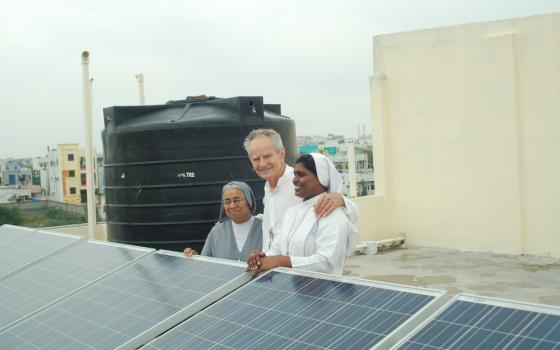Balance, it seems, is often the real key to success for any organization with a mission.
You can’t, after all, do everything. And you can’t always do the things you’d like to in exactly the way you’d like to do them. You have to find a balance between the mission at hand and the resources available.
That was the dilemma Paul Wilkes found himself in. In 2006, Paul founded Homes of Hope India-U.S. to support orphanages and schools for street children in India. The non-profit wanted to build a new orphanage in Uppal, India, but they also wanted to build it to the highest environmental and sustainability standards.
“We wanted to demonstrate that building for the poor can still be economical and ecological,” Wilkes said. “But we had to be very careful – there were a lot of bells and whistles that were just beyond our ability to pay for them.”
But the balance was found – so much so that the Auxilium Navajeevana – Home for Street Girls, which opened late last year, learned in April that it had been awarded a LEED Silver rating. The Leadership in Energy and Environmental Design system rates buildings on their environmental impact. Homes of Hope contributed about three-fourths of the building’s roughly $400,000 cost.
Wilkes is understandably proud: He said it’s the first LEED certified orphanage in India, and possibly the world. The building uses low-flow fixtures, collects, stores and uses rainwater, uses rooftop solar panels to generate 5 kw of electricity, and, of course, is incredibly energy efficient.
Of course, all of this is just a means – a more efficient, sustainable means – to an end, which is serving orphaned girls.
“We’ve had girls that have come to us, they don’t know their age or their name,” Wilkes said. “They’ve lived their entire life on the street.”
Auxilium Navajeevana has a capacity of about 150 girls and currently is home to about 60.
Immigration case still undecided
A three-judge panel of the 5th U.S. Circuit Court of Appeals in New Orleans heard arguments Friday in the case to determine whether President Obama’s executive orders on immigration can be implemented.
At stake are reforms that could protect 5 million people living in the United States illegally from deportation. The panel heard the case after a federal judge in Texas sided with 26 states suing over the executive order and issued an injunction, which the Obama administration appealed.
Either side could appeal a loss to the full 5th Circuit or the Supreme Court, but that didn’t matter to hundreds of people outside the courthouse, who rallied in favor of the reforms.
CRS needs help serving Mali
Catholic Relief Services is asking for help in serving the people of Mali, who have been suffering under up to 281 armed groups roaming the northern part of the country since a coup in 2012.
Nearly 60,000 people have been displaced, livelihoods have been put in jeopardy, and displaced families – most with children and many headed by women – have immediate needs for food, shelter and necessities.
Help starting a new life
Refugees resettled to the United Kingdom, meanwhile, have been getting help learning to live their new lives through the United Nations High Commissioner for Refugees’ Gateway Protection Programme.
“Imagine how it would feel to live with your family in a refugee camp, unable to return home because of war or persecution,” the report says. “Now imagine what it would be like to taken from that place and moved, in a matter of days, to somewhere safe – but different to anywhere you’ve ever lived before.”
Gateway staff and volunteers help the refugees find their way around an unfamiliar city, learn to use household appliances, find where to buy food, get used to the cold weather, learn English, get their children into school and find work.
The scorching sun gets put to work
In Zimbabwe, meanwhile, Oxfam is using solar-powered pumps to help local farmers. Women had been spending up to six hours a day hauling buckets of water to irrigate their crops; now it can be done in an hour or two.
The potential of irrigation is being realised on an even bigger scale at the Ruti dam irrigation site. There 60 hectares are being watered and cultivated and the results have been remarkable, and demonstrate the way 270 smallholder farmers who were previously growing little more than subsistence crops of maize can feed themselves, earn income and benefit their neighbours.
Two thirds of the Ruti scheme benefit from gravity-fed irrigation and now a third phase of production is well under way using two solar booster pumps that pump water to a night storage reservoir.
Irrigation enables farmers to grow three crops a year, and rotate crops to grow a diversity of food crops and cash crops like potatoes and sugar beans.
An Oxfam evaluation in 2012 found that household incomes for the very poor in the area served had increased 286 percent.
Future plans call for a solar-powered refrigeration system for a fish-farming project.
Remember, links, tips and accounts of the response to any crisis anywhere in the world are always welcome at [email protected].
[Dan Stockman is national correspondent for Global Sisters Report. Follow him on Twitter @DanStockman or on Facebook.]

